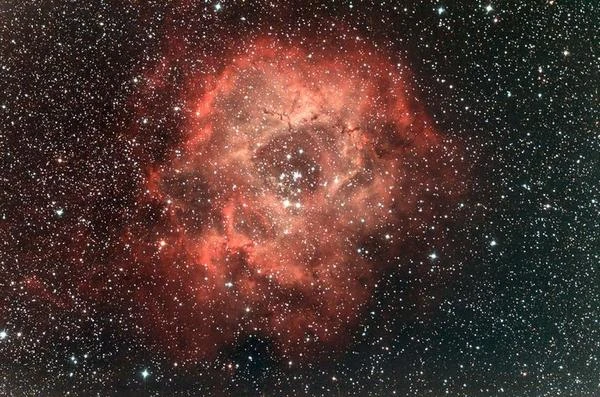
The Rosette Nebula, cataloged as NGC 2237, is a vast cloud of gas and dust located in the Monoceros constellation, about 5,200 light-years from Earth. It spans over 100 light-years and features a petal-like structure sculpted by the stellar winds and intense radiation from the open cluster NGC 2244 at its center. This cluster consists of several hundred to over 2,500 young, massive stars of types O and B, whose influence is decisive in shaping the morphology and evolution of the nebula.
N.B.:
O and B-type stars are very hot and massive, with typical masses ranging from 8 to 60 M☉ for B stars and 16 to 120 M☉ for O stars. Their surface temperatures range from 10,000 K for B stars to over 30,000 K for O stars, giving them intense ultraviolet radiation. They have relatively short lifespans, from a few million to about twenty million years, and their powerful stellar winds strongly influence the surrounding interstellar medium.
Stellar winds, composed of charged particles, exert pressure on the surrounding gas. This pressure, combined with the effect of shock waves, can compress the gas and trigger the formation of new stars. Observations show that the speed of these winds can reach several thousand km/s, thus altering the structure of the nebula on astronomical timescales.
The massive stars of NGC 2244 produce intense ultraviolet radiation capable of ionizing the hydrogen in the surrounding cloud. This process generates the characteristic Hα luminescence of the nebula. Additionally, the stellar winds exert mechanical pressure that pushes matter away, thus carving out a central cavity. This interaction creates a subtle balance between gas dispersion and compression of peripheral regions, conditions favorable to the birth of new stars.
| Name | Spectral Type | Apparent Magnitude | Mass (M☉) | Comment |
|---|---|---|---|---|
| HD 46223 | O4V((f)) | 8.16 | 50 | A very massive star, one of the main sources of ultraviolet radiation and stellar wind in the cluster. |
| HD 46150 | O5V | 6.74 | 45 | Dominant central star, directly influences the ionization of the surrounding gas. |
| HD 46202 | O9V | 8.18 | 30 | Young massive star, contributes to the formation of the central cavity of the nebula. |
| HD 259135 | B0V | 8.90 | 20 | Massive B-type star, its stellar wind participates in structuring the gas filaments. |
| HD 46149 | O8V | 7.90 | 35 | Massive star, plays a role in the ionization of the peripheral regions of the nebula. |
| HD 46056 | O7V | 8.05 | 40 | Important central star, contributes to the overall dynamics of NGC 2244. |
| HD 46106 | O9V | 8.23 | 30 | Young star, local influence on star formation in neighboring small clusters. |
| HD 259105 | B1V | 9.12 | 15 | B-type star, its UV radiation participates in the ionization of peripheral gases. |
| HD 46285 | O9V | 8.45 | 30 | Massive star contributing to the central cavity and stellar wind pressure. |
| HD 46150B | O5V | 7.95 | 45 | Companion of HD 46150, also very massive, reinforces energetic feedback on the cloud. |